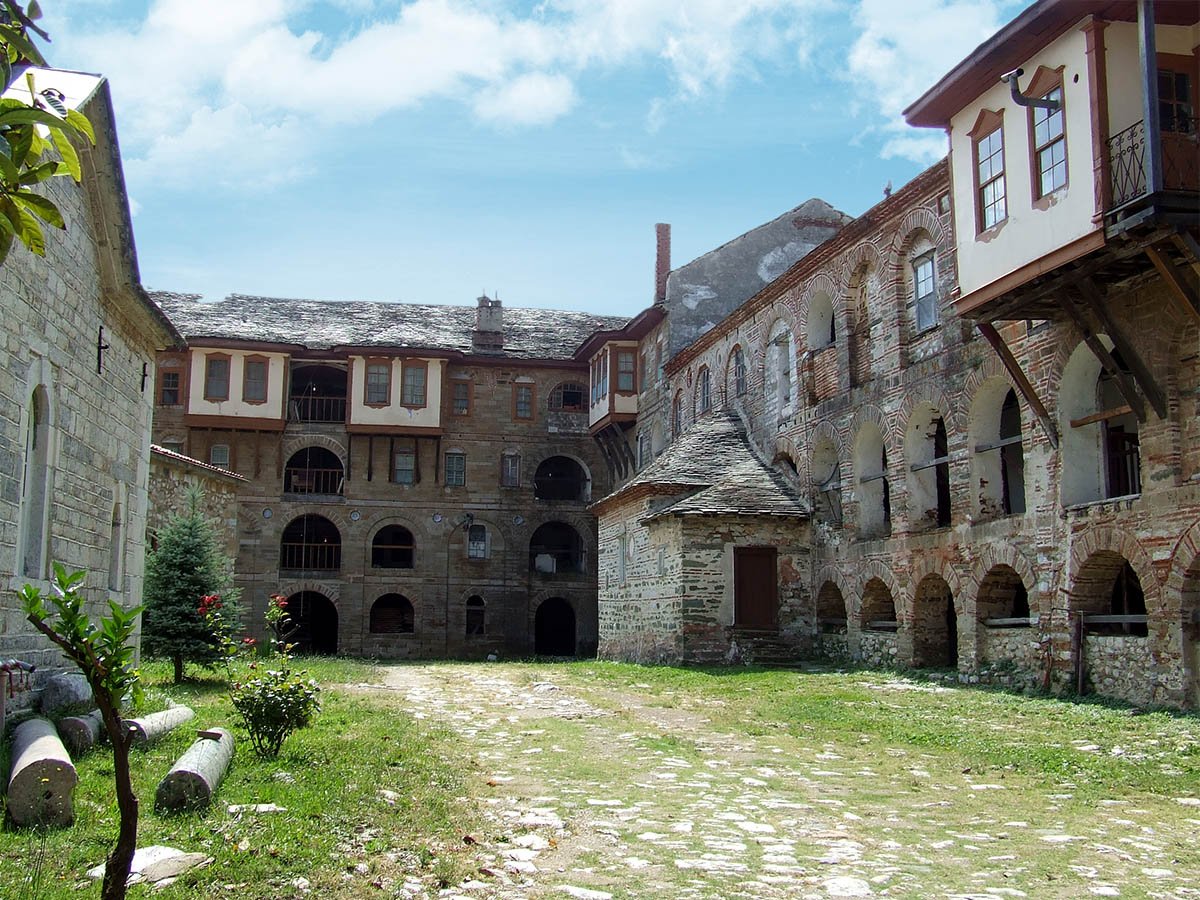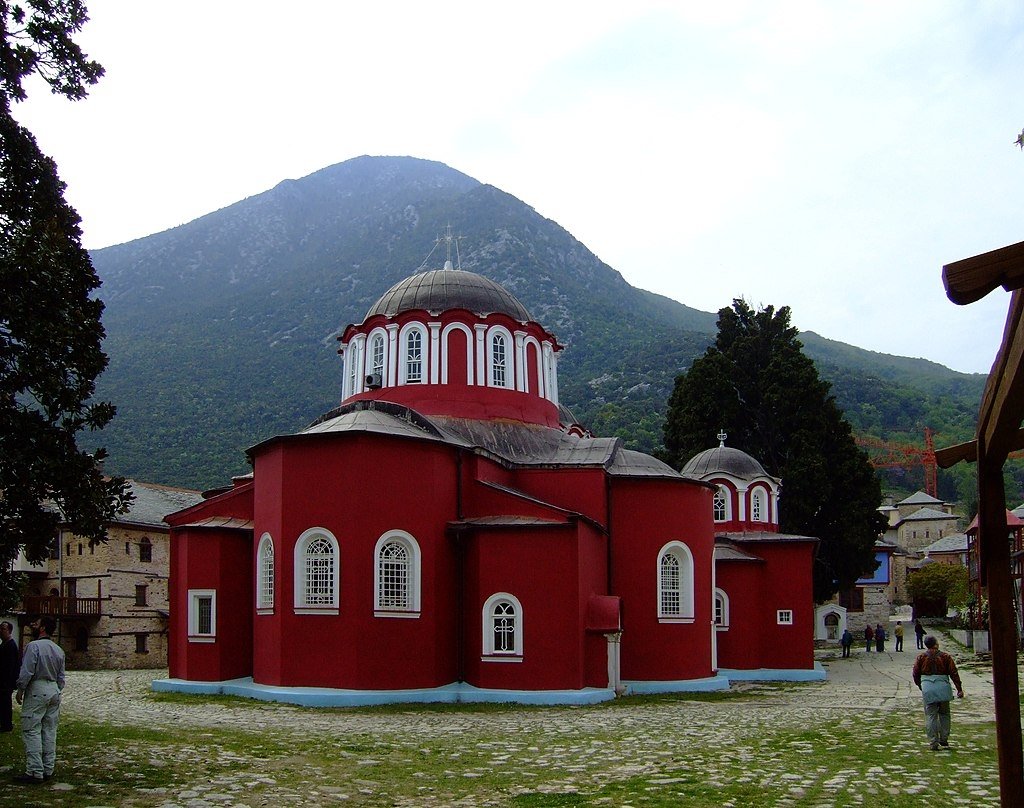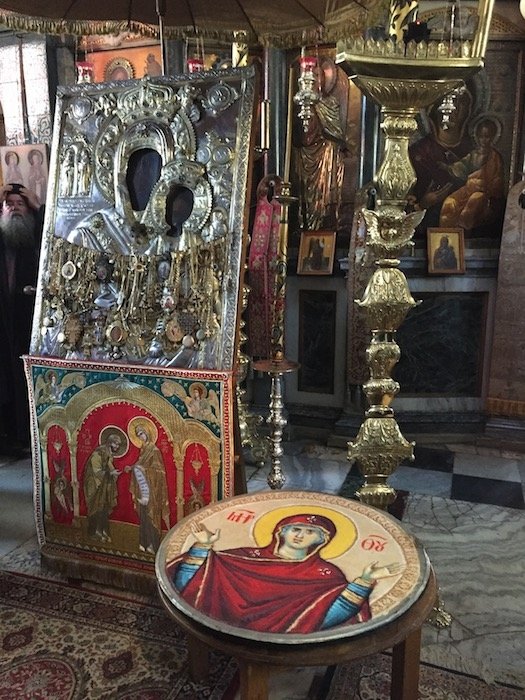Where is the Holy Monastery of Great Lavra?
The Holy Monastery of Great Lavra is located on the south-eastern tip of the Athonian Peninsula on a rock plateau. The Monastery is about 20 minutes' walk from the coast, i.e. from Arsana, while from the capital, Karyes, it is about 1.5 hours by car, or 7 hours by foot.
For ten centuries, the Holy Monastery of Great Lavra has been in the first place in the hierarchical ranking of the monasteries of Mount Athos. In addition, it is the largest Monastery in area, with a total of 72,000 acres, within which a helipad has also been built.
The monastery is one of the most imposing on Mount Athos, it has fortification towers, as well as special constructions to deal with pirate raids. Essentially, it was about the "boilers" at the entrances of the Monastery, from where the monks poured hot oil, when the pirates invaded the monastery.
Outside the monastery is the watermill, the cemetery, arable land and the hermitage of Saint Athanasios the Athonite high up on the mountain.
When was the Holy Monastery of Great Lavra founded and who is its founder?
The Holy Monastery of Great Lavra was founded in the year 963 AD. on the ruins of the ancient city of Akroathos, by Saint Athanasios the Athonite.
Athanasios was working as a professor in Constantinople and in 957 AD. decided to move to Mount Athos. General Nikephoros Phokas was a personal friend of Athanasios, who offered Athanasios financial help to build the monastery. In fact, when Nikephoros Phokas became emperor, the Lavra became a Royal Monastery and received rich grants.

Periods of prosperity and decline of the Holy Monastery of Great Lavra
From its foundation, the Great Lavra followed the organization of the communal monasteries, which caused the dissatisfaction and reaction of the traditional hermits of Mount Athos. Finally, a new system of organization was defined, which allowed the coexistence of the patrimonial and coenobium systems.
Thus, the Holy Monastery of Great Lavra was the first large community on the Athonian peninsula, starting with 80 monks. Essentially, the Great Lavra is considered the monastic beginning on Mount Athos, and Saint Athanasios the Athonite is considered the founder of communal monasticism.
The Holy Monastery of the Great Lavra experienced long periods of prosperity and hosted a large number of monks over the centuries. A typical example of the power of the monastery is that at the end of the 10th century the Great Lavra counted 160 monks, while in the 11th century this number increased to 700.
The "golden" century of the Great Lavra and its fall
In the 14th century there was the greatest and most significant period of flourishing of the Monastery. During this period, many important Holy Fathers decided to take monastic vows in the Holy Monastery of Great Lavra, among them the great hesychast Saint Gregory the Palamas.
However, during the 15th century the Monastery was in danger many times, from successive pirate attacks, raids and disasters. The unfavorable conditions experienced by the Monastery led to the adoption of the peculiar mode of operation, so that it managed to stay alive.
During that period, the monks of the Great Lavra took advantage of the favorable privileges and the relationship they had built with the Byzantine Emperors and managed to get back on their feet relatively quickly.
First, they repaired the damaged buildings and then redecorated the Church and the Chapels with frescoes. Thus, in March 1575 the Monastery returned to the communal system with the sigillion of Patriarch Jeremiah III.

The new heyday of the Great Lavra
The new flourishing phase of the monastery lasted until the 18th century. During this time, the Great Lavra gained so much power that it helped the other monasteries by paying the taxes on their behalf.
At the end of the 18th century, the Monastery falls into decline again. It is worth noting that in the middle of the 18th century, the first printing workshop in Greece was established in the Monastery of Great Lavra.
During the Revolution of 1821, the Monastery of Great Lavra had 117 monks and 448 dependents (hermits, and monks who lived in Sketes or Cells). In fact, many of the monks actively participated in the Greek War of Independence in 1821.
The Church of the Great Lavra
The Church of the Monastery was built between 963 – 1003 AD. with grants from the emperors Nikephoros Phokas and Ioannis Tsimiskis. It is the first church built on Mount Athos and essentially served as a model for the churches built in the following years on the Athonian peninsula. Inside there are exquisite frescoes by the Cretan iconographer Theophanis, which date from 1535.
The Church is built in the center of the courtyard and is commemorated on the Dormition of Saint Athanasios the Athonite (July 5), who had dedicated it to the Annunciation of Virgin Mary, when he originally built it. Attached to the Church are the two large chapels of the monastery, that of the Forty Holy Martyrs, where the tomb of Athanasios the Great is located, as well as the chapel of Saint Nikolaos.

In addition, a Litany Cross dating back to the 10th century, relics of a hundred Saints, portable icons, gold-plated sacred vessels, vestments and old liturgical books are kept in the church.
In addition, in the garden of the Monastery is the church of Panagia Koukouzelissa, which is considered as the second Church of the Monastery. Panagia Koukouzelissa is honored every year on October 1st.
The Library of the Monastery of Great Lavra
The Library of the Great Lavra was founded by Saint Athanasios, founder of the Monastery. Initially, the Library was housed in the Church and the Tower of Tsimiskis. From 1870, however, until today, all books and manuscripts are kept in a building to the east of the Church.
From the first centuries when the Library was organized, there was also a "Scriptorium", i.e. a workshop where the monks copied the Codices. Today, the collection of the Great Lavra consists of 3,000 Codices, 700 of which are on parchment and the rest on paper.
In fact, twelve of the parchments date back several centuries and have beautiful miniatures, of excellent Byzantine art. The Library of the Great Lavra is among the three largest libraries of Byzantine manuscripts.
In addition, 200 Imperial Gold Coins and approximately 20,000 Greek, Byzantine and post-Byzantine documents are kept in the Library of the Monastery.
Equally large is the number of official documents of other countries, which date from the 14th to the 19th century: about 10,000 Turkish, Romanian, Slavic, Latin and Arabic documents. These figures rank the collection of the Holy Monastery of Great Lavra as the largest on Mount Athos.

The relics of the Monastery of Great Lavra in the Sacristy
In the sacristy of the Holy Monastery of Great Lavra, valuable relics are kept that bear witness to the history of many centuries. Among the most important relics are the crown and the Gospel of Nikephorus Phokas, as well as his imperial garment, the "sack". In addition, the staff of Saint Athanasios and many relics of Saints are kept in the Monastery.
The most important icon of the Monastery is that of the Most Holy Theotokos of Koukouzelissa, as well as the Panagia Economissa. In addition, the Monastery keeps an icon of Jesus Christ from 843 AD, an icon of Saint John the Theologian, the holy icon of the Mother of God and the icon of the miracle performed by Saint Athanasios.
The Holy Monastery of Great Lavra has hundreds of cells, while approximately forty-five of them are inhabited at intervals. The cells of the Monastery are located in the areas of Provata, Morfonou, Kerasia, Agios Nilos and Karyes. The Hermitages of the Monastery are located in the areas of Katounia, Karoulia, Agios Vassilios, Bouleutria and Vigla.
Contact with the Monastery of Great Lavra:
Contact Phone: +30 23770 22586 & 23770 23754

















